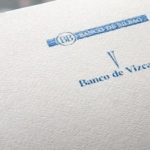Brief history of BBVA (XXI): Bilbao and Vizcaya, even more important
The subsequent legal reform that took place in the 1950s and early 1960s bore their fruit in the economy and in the banking sector. In the latter, the biggest banks, especially those from Vizcaya, were stronger thanks to a liberalized panorama that enabled their growth and expansion following two complicated decades in the Franco regime.

Banco de Bilbao and Banco de Vizcaya
Under the presidency of Gervasio Collar y Luis – who was named the head of the Banco de Bilbao following Julio de Arteche’s death in 1960– and after a period of recession and recovery from 1959 a 1963, the Bilbao-based bank experienced a bountiful decade from 1963 to 1974. Spain’s economic recovery enabled the Banco de Bilbao to grow substantially in credit and discounts. Remarkably, the bank was even able to increase its business during the years of recession.
Discounts performed significantly better than assets and the investment portfolio, with two-thirds in government funds, remained stable. During these years, attention was focused on current customers and a high level of liquidity was sought in anticipation of possible future growth. The bank also increased its capital and provided significant reserves against its profit. In the preliminary planning phase, all these steps indicated that it was focusing on an upcoming period of growth rather than on maximizing the profitability of its business in the short term. Despite its conservative behavior, the Banco de Bilbao’s average value multiplied by 1.4, largely due to the considerable increase in external assets in the form of deposits.

Gervasio Collar y Luis, by Enrique Segura - BBVA Collection
The Bilbao-based bank took also took advantage of the opportunity to expand by increasing the number of branches, which rose from 197 in 1959 to 209 just four years later in 1963. After the LOCB of 1962, it created its own industrial bank, just like its rivals, the Banco Industrial de Bilbao, an endeavor sparked by the change in regulations that gave clues as to the bank’s belief in continuing to bet on industrial investment. Its investment portfolio grew significantly in public funds (8.1%) and other securities (4.2%) in the decade from 1964 to 1974 – an indicator of its interest to continue in mixed banking. The Banco de Bilbao maintained a strategy of sustained participation in the new industrial growth process, with significant growth in its industrial securities portfolio, bolstered by growth in discounts and short-term credit renewed by its customers.
At the end of the 1960s and taking advantage of the banking expansion plans overseen by the Bank of Spain, big banks threw themselves into increasing their stakes in other institutions and in some cases acquired medium-sized banks through mergers. The starting gun to this new way of doing things went off in 1968 and the bulk of the operations took place in the following five years. For the Banco de Bilbao, Gervasio Collar focused on acquiring some of the institutions in which the bank had stakes (in some cases since 1930). This led to the Banco de Bilbao mergers with the Banco Asturiano de Industria y Comercio (Oviedo), the Banco Castellano (Valladolid), the Banco de La Coruña and the Banco de Irún.
The Banco de Bilbao’s growth from 1959-1974 was very remarkable, and even reached an accumulative annual growth rate of 11.76% in real terms.
The last decade and a half of the Franco regime was also a success for the Banco de Vizcaya. Under the presidency of Pedro de Careaga y Basabe, the bank reinforced its well-known characteristic of being a bank that bet on industrial investment. During this time period it participated in the establishment of important institutions by Intermedios y Colorantes, S.A. (Incosa), Petróleos del Norte, S.A. (Petronor) and Altos Hornos del Mediterráneo, as well as the birth of its own industrial institution: the Banco de Financiación Industrial (Induban).
In addition, in 1969, it joined the period of bank acquisitions, acquiring Banca Villela, which had an extensive network of branches in Catalonia. It’s also important to note the Banco de Vizcaya’s bet on creating new financial companies, including the real estate investment company Finsa (1965), the asset management company Gesbancaya (1970) and the leasing company Liscaya (1972). Similarly, the arrival of new forms of payment like credit cards and ATMs led the bank’s executives to decide to take a stake in an international company like Eurocard. In 1972, the Banco de Vizcaya also joined the insurance company Plus Ultra, founded in 1887.

Banco de Vizcaya becomes a shareholder in Eurocard in 1970.
But the Banco de Vizcaya’s notable growth did not only take place externally, but also modernized the bank internally through the unification and mechanization of the IT and administrative networks in 1967, which helped to reduce the bank offices’ administrative tasks considerably.
Even though it was a younger and smaller bank than Banco de Bilbao, Banco de Vizcaya had an accumulative annual rate of 9.67% from 1959 to 1974 in real terms.